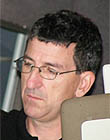|
|
This topic comprises 2 pages: 1 2
|
|
Author
|
Topic: Overdue Indictment of Shaky-Cam?
|
Michael Coate
Phenomenal Film Handler

Posts: 1904
From: Los Angeles, California
Registered: Feb 2001
|
 posted 03-16-2011 10:58 AM
posted 03-16-2011 10:58 AM




Salon Article
quote:
Time to declare war on the shaky camera
The obnoxiously photographed "Battle: Los Angeles" shows how utterly bankrupt a movie technique has become
By Matt Zoller Seitz
How to describe the aggressive dreadfulness of "Battle: Los Angeles," maybe the worst-directed Hollywood movie I've ever seen? Incompetent doesn't do the trick, because it implies an inability to master basic craft. That's not the case here. "Battle: Los Angeles" takes one of the more controversial cinematography fads of recent years -- the "shaky camera and shallow focus equals 'reality'" fad -- to noxious new levels of excess. The movie is the work of professionals who decided to make their film look bad on purpose.
It's a science fiction war movie shot like a YouTube record of a natural disaster -- only much more so. Frankly, the most chaotic footage from the most terrifying disasters of recent times is more visually comprehensible than most of the shots in this expensive action film. Director Jonathan Liebesman and cinematographer Lukas Ettlin shoot most of the action with a very long lens, which gives the images a narrow plane of focus, and they appear to move the camera around more or less at random to make the action feel more "real" or "documentary-like" or something. I say "or something" because the idea that this type of image is "realistic" or "documentary-like" is nonsense. Look at actual documentaries of combat in war zones and you will rarely see any images as chaotic, junky, poorly framed and visually impenetrable as the ones that occupy 90 percent of the running time of "Battle: Los Angeles."
To call this approach amateurish would libel amateurs. A quick check of YouTube will reveal many taped records of spectacular and terrifying events where the camcorder or flip phone is rock-steady, there's depth of field, everything is in focus, and the shot holds for 10 seconds, a minute, two minutes or longer -- characteristics that actually intensify the level of fear, awe and helplessness, because they let you imagine yourself into another physical space and see where objects and people are in relation to each other.
This isn't possible when a shaky camera is combined with very rapid cutting, the default style of modern blockbusters. It's the fad style that dominates filmmaking in the early 21st century, just as excessive and unmotivated zooms dominated the psychedelic late '60s and early '70s. The filmmakers' unspoken (in some case probably unconscious) agenda is to deny the audience a fixed vantage point on anything, for any reason, ever -- not just to jack up their adrenaline level, but perhaps to cover weak storytelling, acting, writing or special effects with visual clutter and waste motion. It's the style that directors embrace when they have no style -- a substitute for vision.
Simply put, this crap is transparently cynical and opportunistic and has become totally played-out since 1999's "The Blair Witch Project," arguably the hit that made home video panic-cam an official, approved technique in mainstream productions. But 12 years later, directors who keep treating it as an aesthetic security blanket -- especially at the big-budget level -- should be required to get a tattoo across their foreheads that reads "Hack." Get yourself a tripod. Make a shot list. Think about where you're putting the camera and why you're putting it there, and try to redirect the audience's attention by moving the camera or refocusing rather than cutting every three to five seconds. Stop covering action. Start directing again.
I should back off from my attack for a moment and say that I'm a bit surprised to find myself blasting the shaky cam school of cinematography. In certain cases, I have defended it when many of my colleagues were calling it evidence of the death of cinema aesthetics. Critics David Bordwell and Jim Emerson, in particular, have mounted blistering attacks on the shaky camera/fast cutting style as seen in the films of Paul Greengrass ("United 93," the "Bourne" trilogy). And we've seen similarly intense attacks on other films and TV series that adopt a pseudo-documentary style, such as "24" and "Cloverfield" and "Gangs of New York," "Gladiator," "Black Hawk Down," "Kingdom of Heaven" and other movies that were too obviously trying to ape the combat sequences in "Saving Private Ryan."
"Gangs," "Gladiator," "Black Hawk Down" and "Kingdom" used shaky cam in a way that was boring and disappointing considering their directors' track record of displaying visual imagination elsewhere. But I defended "Blair Witch," the "Bourne" films, "Cloverfield," "24" and "Ryan" because the style seemed to have dramatic or contextual justification, and because the camerawork, though outwardly rough, showed grace and intelligence; it wasn't shaking all over the place at all times, and cutting every few seconds just because. The "Bourne" films would have been just as exciting, maybe more exciting, if they'd been shot in a more traditional way, but at least you can defend their jumpiness as an extension of the hero's paranoid mind-set and his ability to process massive amounts of information in a short timespan. Matt Reeves' "Cloverfield" -- which was presented as "found footage" by an honest-to-goodness amateur -- is wild during the running scenes but comprehensible elsewhere, and it relies on long takes and moves to reveal things; its timing is expert. The brain-dead aping of "Ryan" by lesser filmmakers suggests poor visual comprehension on the imitators' parts. The battle sequences in "Ryan" are quick-cut and chaotic, but there are some very long takes mixed in there, too, and when the bullets aren't flying, director Steven Spielberg moves the camera patiently, elegantly, always with a purpose, never cutting unless he absolutely has to, and there are times when he nails the camera to the floor or mounts it on dolly tracks and observes people moving through the frame in wide shot, framed from head to toe. Spielberg doesn't apply shaky cam to every moment, only when he thinks it might add a newsreel-like immediacy.
Not so with "Battle: Los Angeles." The shaky cam, shallow focus, tight close-ups and fast cutting don't just deny us a good look at the space creatures or the mayhem they commit, they deny the viewer a chance to study the anxious, thoughtful faces of the Marines the story is allegedly about. And the shaky cam isn't just used in moments of intense action. The filmmakers apply it to everything: Staff Sft. Michael Nantz (Aaron Eckahart) doing sit-ups on a beach or having a touchy conversation with a superior officer; the men playing a quiet game of golf on a closed course at night. We're supposed to mistake this for documentary realism. But the longer you watch, the more you begin to suspect that the movie has no personality of its own, just a bag of tics, and is made in the style that happened to be popular in 2011. The current "Red Riding Hood," directed by Catherine Hardwicke of "Twilight," is nearly as worthless, but at least the bob-and-weave camerawork is slower and more genteel; you might get mild motion sickness from watching it, but that's a step up from "Battle: Los Angeles," which comes on like a prankster sneaking up behind you and shaking you violently by the shoulders.
I've decried the shaky, shallow-focus, cut-cut-cut, all-exclamation-points style of Michael Bay ("Transformers"), but I'll say this for him: He can frame a shot. He understands depth, balance and the concept of blocking physical action in a way that is dynamic and attractive to look at. You cannot say the same for "Battle: Los Angeles," which looks as if the cinematographer strapped cameras to the heads of a dozen baboons and fired pistols over their heads when the director called "action."
Show some craft and wit, filmmakers, please. Or get yourself a new fad. This one's over.
| IP: Logged
|
|
|
|
Bobby Henderson
"Ask me about Trajan."

Posts: 10973
From: Lawton, OK, USA
Registered: Apr 2001
|
 posted 03-16-2011 12:35 PM
posted 03-16-2011 12:35 PM




Yeah, the indictment of shaky cam is very long overdue. We've been bitching about it for a long time here at Film-Tech. I think I started complaining about it in the 1990s when NYPD Blue and Homicide were on TV airwaves.
Think about what has been going on the past 20 years. In the late 1980s and early 1990s a lot of music video directors and guys who made TV commercials were moving into feature film production. They caught plenty of flak from the "old guard" would couldn't stand all the rapid edits and artificial looking camera shots. Grad filters anyone?
Now those former music video directors are the "old guard" and many of their bad habits are now institutionalized ways of movie-making. The "new guard" is building on those music video inspired bad habits with reality TV inspired bad habits. You know what you get when you take some shit and stack it on top of some other shit? You get even more shit!
I think Brad Miller summed it up best in his 2004 review of The Bourne Supremacy:
quote: Brad Miller
I am going to have to find this director and clamp his head in a paint shaking machine for two hours so he can see the kind of shit he is making.
Of course I get a pretty funny visual from this:
quote: Matt Zoller Seitz, Salon
You cannot say the same for "Battle: Los Angeles," which looks as if the cinematographer strapped cameras to the heads of a dozen baboons and fired pistols over their heads when the director called "action."
The Bourne Supremacy was definitely hurt by its over-use of shaky cam. The technique made action sequences very difficult to follow. I remember one fight scene between Matt Damon and a bad guy that took place inside a house. It was absolute crap. Unintelligible. As usual, Paul Greengrass had the camera shaking and swishing all over the damned place. Worse yet, the shots were composed way too tight. And I guess the crew didn't want to screw around with any studio lights. In the end you're trying to follow a fight between two blurry silhouettes. They're lit by the daylight coming in through the windows, daylight of a cloudy, dreary day. I could shoot available light video of my toilet bowl and it would look more pleasant than that swill.
I don't consider Saving Private Ryan to be a standards bearer of sorts for the shaky cam technique. SPR doesn't need any blame for that. Sure, some shots are hand held. But we don't see any of the shaky shaky bang & quakey nonsense slathered on as "visual style." The camera man isn't having frequent ADHD brain farts letting the shot composition drift left or right then trying to regain it. The look of SPR only meant to mimic certain clips of combat photography. I think the visuals in SPR that got more attention (some of it negative) was the movie's grainy, gritty look and Janusz Kaminsky throwing those vertical streaking reflections into a few shots.
Also look at a movie, such as The Rock, made a couple years before Saving Private Ryan. It has a fair number of seizure cam style shots I found very distracting (shaking camera zooming in/out of actor's face was a frequent visual gag during a car chase). Luckily Michael Bay liked dolly and crane shots enough to use those quite a bit instead of shaking the camera the entire movie.
It's scary to think of what could happen if a movie like Lawrence of Arabia were re-made today. We can all forget about that 12 minute long scene involving Omar Sharif's unforgettable entrance out of the desert. There's absolutely no way any modern director could stand to hold shots that long. Forget about the camera being mounted to a tripod or dolly system. Gotta throw the color balance into some dreary urine colored look. And it might as well be shot on video!
| IP: Logged
|
|
Mark Ogden
Jedi Master Film Handler
Posts: 943
From: Little Falls, N.J.
Registered: Jun 99
|
 posted 03-16-2011 12:54 PM
posted 03-16-2011 12:54 PM




I saw Battle: Los Angeles and followed it completely and understood it thoroughly despite the shaky-cam footage. I understood at all times where and when the action was taking place, who had the upper hand and when, and I noticed plenty of “anxious, thoughtful faces” on the players. Also, despite what is written in the article, the film has a strong, compelling “personal redemption” story that is easily discerned, rapid cutting notwithstanding.
Shaky-cam is simply a stylistic choice, as was: the low angle, deep focus shots of Citizen Kane, the colored filter shots of South Pacific, the long interstitial shots of Floating Weeds and Tokyo Story, the motion capture replacement of live actors in Avatar , the first-person floating overhead shots of the recent Enter The Void, the phony dirt, scratches and gate weave of Grindhouse, the on-camera onomonopia of Scott Pilgrim vs. The World, the alternate handheld and locked-off tripod shots of Paranormal Activity and on and on and on.
I’m not a big fan of the technique, but if a director wants to use it to make his movie, he should be allowed. Matt Zoller Seitz, on the other hand, should go back to yelling at kids to stay off his lawn.
| IP: Logged
|
|
|
|
Bobby Henderson
"Ask me about Trajan."

Posts: 10973
From: Lawton, OK, USA
Registered: Apr 2001
|
 posted 03-16-2011 01:26 PM
posted 03-16-2011 01:26 PM




quote: Mark Ogden
I’m not a big fan of the technique, but if a director wants to use it to make his movie, he should be allowed. Matt Zoller Seitz, on the other hand, should go back to yelling at kids to stay off his lawn.
I think the viewer, which is often the paying customer, has a right to say shaky cam is shit. And much of the time it is indeed shit.
Gratuitous shaky cam use in a throw-away alien invasion movie doesn't deserve any sort of placement alongside Gregg Toland's deep focus cinematography and dramatic camera angles in Citizen Kane. As ground-breaking as Citizen Kane was in its "style" and ability to redefine the visual language of film-making, everything in that movie was done to serve the story.
There's nothing ground-breaking at all in Battle: Los Angeles, including the use of shaky cam.
| IP: Logged
|
|
|
|
|
|
|
|
Mark J. Marshall
Film God

Posts: 3188
From: New Castle, DE, USA
Registered: Aug 2002
|
 posted 03-16-2011 03:23 PM
posted 03-16-2011 03:23 PM



I can forgive seizure cam on one condition - that it make sense that the camera is shaking. Blair Witch worked just fine for me when it came out. A bunch of teenagers walking through the woods with hand held cameras to shoot stuff - makes sense that the cameras were shaky. And the shots of them actually doing the documentary that they set out to make - were rock steady as they should have been.
If I ever see Cloverfield, I might say the same thing about that movie.
Bourne doesn't work for me. It's over played. When two guys are sitting in a room talking and the shots on guy #1 are rock steady and the shots on guy #2 are all over the place - that doesn't compute in my head. It fails.
As for 24, I don't buy that either unless we're standing next to a car that blows up. Then, yes, the camera will shake. I saw a behind the scenes clip with one of the cameramen where he was talking about the shakey cam and he said something to effect of, "I keep everything moving... I'm always searching for the frame." Hey, buddy. Find the frame BEFORE you start shooting.
I get sucked out of movies and TV shows so often because of cameras shaking all over the place. This ridiculous, unwarranted, unjustifiable, lazy, pathetic, unprofessional, idiotic, infuriating technique has cause me to hate more movies that I should have liked than I care to count. And at some point I firmly believe that people will look back on this era in film making and marvel at how many movies were made that could have been great but are almost completely unwatchable or at the very least un-enjoyable.
| IP: Logged
|
|
|
|
|
|
|
|
|
|
|
|
|
|
All times are Central (GMT -6:00)
|
This topic comprises 2 pages: 1 2
|
Powered by Infopop Corporation
UBB.classicTM
6.3.1.2
The Film-Tech Forums are designed for various members related to the cinema industry to express their opinions, viewpoints and testimonials on various products, services and events based upon speculation, personal knowledge and factual information through use, therefore all views represented here allow no liability upon the publishers of this web site and the owners of said views assume no liability for any ill will resulting from these postings. The posts made here are for educational as well as entertainment purposes and as such anyone viewing this portion of the website must accept these views as statements of the author of that opinion
and agrees to release the authors from any and all liability.
|

 Home
Home
 Products
Products
 Store
Store
 Forum
Forum
 Warehouse
Warehouse
 Contact Us
Contact Us




 Printer-friendly view of this topic
Printer-friendly view of this topic
















